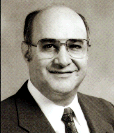Saving Limbs and Lives
 Sue and William Wall enjoy a day in
the park with their son Jack.
Sue and William Wall enjoy a day in
the park with their son Jack.-
-
- Austin attorney Sue Wall dismissed the little lump above her right knee as a result of
too much lifting and ladder climbing while moving into a new house. When the pain
worsened, she went to a doctor, had diagnostic tests that found a bone tumor and was sent
to a surgeon.
-
- Her surgeon scheduled an amputation.
-
- "I was absolutely terrified," she says, shuddering as if the experience had
been last week instead of nine years ago. At the time, she was 27, recently married and
getting established in her legal career.
-
- The physician she consulted for a second opinion advised Wall to go to M. D. Anderson
and then arranged for her to see Dr. Robert S. Benjamin, chairman of the Department of
Melanoma and Sarcoma. Imaging studies and other tests indicated the cancer, an
osteosarcoma, had not spread beyond its primary site. Dr. Benjamin told her she was a good
candidate for a three-part therapy that included limb-sparing surgery.
-
- Wall had four courses of intensive combination chemotherapy followed by surgery, in
which the tumor-bearing bone was removed and replaced with a metal prosthesis. Then she
received more chemotherapy designed to destroy any stray cancer cells that might have
escaped and metastasized to distant organs. Her prognosis for long-term survival was
positive.
-
- "After awhile, I felt so good that I asked Dr. Benjamin about trying to have a
baby. He never said I wouldn't be able to get pregnant, but I could tell he wasn't
optimistic," she says.
-
- Meanwhile, Wall and her husband, William, who teaches fourth and fifth graders, were
enjoying life. They walked, rode bikes, swam and traveled as much as possible. Her
prosthesis stood the test of sight-seeing trips to Mexico and Portugal as well as
strenuous hiking and horseback riding in Costa Rica. She was happy specializing in
property law. As the years passed, she gradually gave up hope for having a baby.
-
- "I was thrilled when I got pregnant in the summer of 1996. My pregnancy was quite
normal, and my right leg held up fine even after I gained weight . . . William and I were
absolutely elated when Jack was born on March 20, 1997 . . . Today, I am bursting with
gratitude for the blessings of good health and for our wonderful family," Wall says.
-
-
 "Our foremost priority always is saving patients' lives. Through
limb-salvage therapy, we also strive to provide an optimal quality of life by avoiding
amputation." - Dr. Robert S. Benjamin
"Our foremost priority always is saving patients' lives. Through
limb-salvage therapy, we also strive to provide an optimal quality of life by avoiding
amputation." - Dr. Robert S. Benjamin-
-
- In retrospect, Dr. Benjamin says he was doubtful about Wall having a baby because the
powerful chemotherapy could have impaired her ability to get pregnant. For a few years
after she finished treatment, he was concerned about her long-term survival. He and her M.
D. Anderson surgeon, who has since retired, followed her frequently for early signs of
metastasis and/or problems with the prosthesis.
-
- "Our foremost priority always is saving patients' lives. Through limb-salvage
therapy, we also strive to provide an optimal quality of life by avoiding amputation of
arms and legs for patients with primary bone cancers and various other sarcomas. We want
all patients to attain their pre-cancer goals whenever possible. In Sue Wall's case, I
tried to help balance her expectations because I didn't want her to be too disappointed if
she couldn't have her own child," Dr. Benjamin says.
-
- Hearing from Wall that Jack had arrived and that both mother and baby were quite well
was one of the happiest phone calls Dr. Benjamin has received.
-
- Limb-salvage therapy, which largely has been developed at M. D. Anderson, was in a state
of tremendous evolution when Wall started treatment in 1988. Today, she is among a group
of almost 100 osteosarcoma patients who have survived disease-free from five to nearly 20
years and are considered cured. Bone cancer is relatively rare so it takes time to follow
a sufficient number of patients and analyze their treatment results.
-
- "In the mid-1970s, we began combining continuous intravenous infusion of Adriamycin
with intra-arterial infusion of cisplatin to destroy as much of the cancer as possible
prior to limb-sparing surgery, and then we gave post-operative chemotherapy in an attempt
to kill metastatic cells. By the late '80s, we had added ifosfamide and high-dose
methotrexate to our chemotherapy regimen. Over the past decade, we have refined our mix of
drugs and intensified some of the doses both before and after surgery," Dr. Benjamin
explains.
-
- Many limb-salvage strategies also apply to patients with soft-tissue sarcomas, which are
newly diagnosed in about 6,600 Americans each year. Osteosarcomas and other bone tumors
account for about 2,500 new cancer cases annually. The vast majority of these tumors occur
in the extremities. Amputation of an affected arm or leg has been the exception for
patients at M. D. Anderson for many years.
-
- Dr. Alan W. Yasko, chief of the Section of Orthopaedic Oncology, says the increasingly
successful management of sarcomas can be attributed to the optimal integration of medical
skills. From a patient's initial appointment, multidisciplinary team members assess
diagnostic test results, discuss treatment options, plan and then evaluate each phase of
therapy, and talk about rehabilitation and quality of life issues.
-
- Opening a dedicated Sarcoma Center last year has allowed team members to interact even
more effectively, he says. The sarcoma treatment team usually consists of a medical
oncologist, general and orthopaedic surgical oncologists, a plastic surgeon as needed,
radiation oncologist, pathologists, two types of radiologists, a rehabilitation medicine
specialist and a psychiatrist, nurses and physical and occupational therapists.
-
- "Our challenge in preparing for and performing limb-sparing surgery is to preserve
as much normal tissue as possible and replace what we take out with a durable prosthesis
or suitable natural materials to give patients the best opportunity for maintaining
function," Dr. Yasko observes.
-
- Better constructed metal prostheses that withstand considerable "wear and
tear" now are available but a lifetime guarantee remains elusive. Such prostheses are
used in about 90 percent of limb-sparing operations for patients from about 15 years and
older. Expandable prostheses allow a greater percentage of younger patients to be
considered for limb-salvage.
-
- "The expandable prostheses are much better designed but still require open surgery
to lengthen them as the youngsters grow. My youngest sarcoma patient undergoing
limb-sparing surgery of the leg was seven. Another child who was five had a prosthesis in
his upper arm," he says.
-
- Donor bones called allografts are used to replace tumor-bearing bones in about 10
percent of osteosarcoma patients. Dr. Yasko says a combination of donor bone and metal
prosthesis is another alternative that may increase the survivorship of the
reconstruction. He cited a couple of patients who have the combined materials from hip to
knee.
-
- Improved imaging studies, notably magnetic resonance and computed tomography, along with
precisely performed needle biopsies are critical to preoperative planning for any
limb-sparing procedure. Plastic surgeons now participate in some operations to help
transfer tissue for use in the reconstructed sites and/or to perform other techniques
aimed at preventing wound complications.
-
- "For the present, our goal is a cured and intact patient who can resume as near
normal function as possible for the duration of his or her lifetime," Dr. Yasko says.
"Ongoing research efforts are focused on improving the quality of life with the
promise of less debilitating therapies and customized tissue-engineered biologic
reconstructions in the future."
Return to
Fall 97
 Sue and William Wall enjoy a day in
the park with their son Jack.
Sue and William Wall enjoy a day in
the park with their son Jack. "Our foremost priority always is saving patients' lives. Through
limb-salvage therapy, we also strive to provide an optimal quality of life by avoiding
amputation." - Dr. Robert S. Benjamin
"Our foremost priority always is saving patients' lives. Through
limb-salvage therapy, we also strive to provide an optimal quality of life by avoiding
amputation." - Dr. Robert S. Benjamin